A Study on Microscale Wind Simulations with a Coupled WRF–CFD Model in the Chongli Mountain Region of Hebei Province, China
Abstract
1. Introduction
2. Methodology
2.1. Study Area
2.2. WRF Model Setup
2.3. CFD Model Setup
2.4. Validation Methodology
3. Physical Schemes and Coupling Methods
3.1. Physical Schemes
3.2. Coupling Methods
4. Results and Discussion
4.1. Physical Schemes
4.2. Coupling Methods
4.3. Microscale Wind Field Simulation
5. Conclusions
Author Contributions
Funding
Conflicts of Interest
References
- Yamada, T. A numerical-simulation of air-flows and SO-2 concentration distributions in an arid southwestern valley. Atmos. Environ. Gen. Top. 1992, 26, 1771–1781. [Google Scholar] [CrossRef]
- Enger, L.; Koracin, D. Simulations of dispersion in complex terrain using a higher-order closure model. Atmos. Environ. 1995, 29, 2449–2465. [Google Scholar] [CrossRef]
- Venkatesan, R.; Möllmann-Coers, M.; Natarajan, A. Modeling wind field and pollution transport over a complex terrain using an emergency dose information code SPEEDI. J. Appl. Meteorol. 1997, 36, 1138–1159. [Google Scholar] [CrossRef]
- Tong, H.; Walton, A.; Sang, J. Numerical simulation of the urban boundary layer over the complex terrain of Hong Kong. Atmos. Environ. 2005, 39, 3549–3563. [Google Scholar] [CrossRef]
- Castelli, S.T.; Reisin, T.G. Application of a modified version of RAMS model to simulate the flow and turbulence in the presence of buildings: The MUST COST732 exercise. Int. J. Environ. Pollut. 2011, 44, 394–402. [Google Scholar] [CrossRef]
- Jiménez, P.A.; Gonzálezrouco, J.F.; Garcíabustamante, E. Surface Wind Regionalization over Complex Terrain: Evaluation and Analysis of a High-Resolution WRF Simulation. J. Appl. Meteorol. Clim. 2010, 49, 268–287. [Google Scholar] [CrossRef]
- Puliafito, S.E.; Allende, D.G.; Mulena, C.G. Evaluation of the WRF model configuration for Zonda wind events in a complex terrain. Atmos. Res. 2015, 166, 24–32. [Google Scholar] [CrossRef]
- Fernándezgonzález, S.; Martín, M.L.; Garcíaortega, E. Sensitivity Analysis of the WRF Model: Wind-Resource Assessment for Complex Terrain. J. Appl. Meteorol. Clim. 2018, 57. [Google Scholar] [CrossRef]
- Dudhia, J.; Gill, D.; Manning, K.; Wang, W.; Bruyere, C.; Kelly, S.; Lackey, K. PSU/NCAR Mesoscale Modeling System Tutorial Class Notes and User’s Guide: MM5 Modeling System Version 3; Mesoscale and Microscale Meteorology Division, National Center for Atmospheric Research: Boulder, CO, USA, 2005. [Google Scholar]
- Walko, R.L.; Tremback, C.J. RAMS: Regional Atmospheric Modeling System (version 6.0)-Model Input Namelist Parameters; Document Edition 1.4; Atmet LLC: Boulder, CO, USA, 2006. [Google Scholar]
- Skamarock, W.C.; Klemp, J.B.; Dudhia, J.; Gill, D.O.; Barker, D.M.; Duda, M.G.; Huang, X.Y.; Wang, W.; Powers, J.G. A Description of the Advanced Research WRF version 3; Mesoscale and Microscale Meteorology Division, National Center for Atmospheric Research: Boulder, CO, USA, 2008. [Google Scholar]
- Lundquist, J.K.; Mirocha, J.D.; Chow, F.K.; Kosovic, B.; Lundquist, K.A. Simulating atmosphere flow for wind energy applications with WRF-LES. In Proceedings of the 18th Symposium on Boundary Layers and Turbulence, Stockholm, Sweden, 9 June 2008; American Meteorological Society: Boston, MA, USA, 2008. [Google Scholar]
- Li, Y.; Sun, X.; Ning, H.; Qin, H.; Zhao, J. An Analysis of the Physical Characteristics of the Summer Low Atmosphere in the Gobi Desert Adjacent to Bosten Lake, Xinjiang, China. Adv. Meteorl. 2018, 2018, 3061282. [Google Scholar] [CrossRef]
- Aitken, M.L.; Kosović, B.; Mirocha, J.D.; Lundquist, J.K. Large eddy simulation of wind turbine wake dynamics in the stable boundary layer using the Weather Research and Forecasting Model. J. Renew. Sustain. Energy 2014, 6, 033137. [Google Scholar] [CrossRef]
- Murakami, S.; Mochida, A.; Kato, S. Development of local area wind prediction system for selecting suitable site for windmill. J. Wind Eng. Ind. Aerod. 2003, 91, 1759–1776. [Google Scholar] [CrossRef]
- Bitsuamlak, G.T.; Stathopoulos, T.; Bédard, C. Numerical evaluation of wind flow over complex terrain: Review. J. Aerosp. Eng. 2004, 17, 135–145. [Google Scholar] [CrossRef]
- Chen, Q. Using computational tools to factor wind into architectural environment design. Energy Build. 2004, 36, 1197–1209. [Google Scholar] [CrossRef]
- Blocken, B.; Carmeliet, J.; Stathopoulos, T. Cfd evaluation of wind speed conditions in passages between parallel buildings—Effect of wall-function roughness modifications for the atmospheric boundary layer flow. J. Wind Eng. Ind. Aerod. 2007, 95, 941–962. [Google Scholar] [CrossRef]
- Tutar, M.; Oğuz, G. Computational Modeling of Wind Flow Around a Group of Buildings. Int. J. Comput. Fluid D 2004, 18, 651–670. [Google Scholar] [CrossRef]
- Li, L.; Hu, F.; Jiang, J.; Cheng, X. An application of the rams/fluent system on the multi-scale numerical simulation of the urban surface layer-a preliminary study. Adv. Atmos. Sci. 2007, 24, 271–280. [Google Scholar] [CrossRef]
- Zajaczkowski, F.J.; Haupt, S.E.; Schmehl, K.J. A preliminary study of assimilating numerical weather prediction data into computational fluid dynamics models for wind prediction. J. Wind Eng. Ind. Aerod. 2011, 99, 320–329. [Google Scholar] [CrossRef]
- Li, L.; Chan, P.W. Numerical simulation study of the effect of buildings and complex terrain on the low-level winds at an airport in typhoon situation. Meteorol. Z 2012, 21, 183–192. [Google Scholar] [CrossRef]
- Miao, Y.; Liu, S.; Chen, B. Simulating urban flow and dispersion in beijing by coupling a cfd model with the wrf model. Adv. Atmos. Sci. 2013, 30, 1663–1678. [Google Scholar] [CrossRef]
- Mohan, M.; Sati, A.P. Wrf model performance analysis for a suite of simulation design. Atmos. Res. 2016, 169, 280–291. [Google Scholar] [CrossRef]
- Bindu, H.H.; Ratnam, M.V.; Yesubabu, V.; Rao, T.N.; Kesarkar, A.; Naidu, C.V. Characteristics of cyclone generated gravity waves observed using assimilated WRF model simulations over Bay of Bengal. Atmos. Res. 2016, 180, 178–188. [Google Scholar] [CrossRef]
- Done, J.; Davis, C.A.; Weisman, M. The next generation of NWP: Explicit forecasts of convection using the weather research and forecasting (WRF) model. Atmos. Sci. Lett. 2010, 5, 110–117. [Google Scholar] [CrossRef]
- Carvalho, D.; Rocha, A.; Santos, C.S.; Pereira, R. Wind resource modelling in complex terrain using different mesoscale–microscale coupling techniques. Appl. Energy 2013, 108, 493–504. [Google Scholar] [CrossRef]
- Bilal, M.; Birkelund, Y.; Homola, M.; Virk, M.S. Wind over complex terrain–Microscale modelling with two types of mesoscale winds at Nygårdsfjell. Renew. Energy. 2016, 99, 647–653. [Google Scholar] [CrossRef]
- Fang, Y.Y.; Xu, H.M.; Zhu, R. Study on Numerical Simulation of Wind Energy Resources Based on WRF and CFD Models. Meteorol. Mon. 2012, 38, 1378–1389. (In Chinese) [Google Scholar]
- Temel, O.; Bricteux, L.; Beeck, J.V. Coupled wrf-openfoam study of wind flow over complex terrain. J. Wind Eng. Ind. Aerod. 2018, 174, 152–169. [Google Scholar] [CrossRef]
- Carvalho, D.; Rocha, A.; Gómez-Gesteira, M.; Santos, C.S. Offshore winds and wind energy production estimates derived from ASCAT, OSCAT, numerical weather prediction models and buoys—A comparative study for the Iberian Peninsula Atlantic coast. Renew. Energy 2017, 102, 433–444. [Google Scholar] [CrossRef]
- Grell, G.A.; Peckham, S.E.; Schmitz, R.; McKeen, S.A.; Frost, G.; Skamarock, W.C.; Eder, B. Fully coupled ‘online’ chemistry within the WRF model. Atmos. Environ. 2005, 39, 6957–6975. [Google Scholar] [CrossRef]
- Li, Y.; Lu, G.; Wu, Z.; He, H.; Shi, J.; Ma, Y.; Weng, S. Evaluation of Optimized WRF Precipitation Forecast over a Complex Topography Region during Flood Season. Atmosphere 2016, 7, 145. [Google Scholar] [CrossRef]
- Pennelly, C.; Reuter, G. Verification of the Weather Research and Forecasting Model when Forecasting Daily Surface Conditions in Southern Alberta. Atmosphere 2017, 55, 31–41. [Google Scholar] [CrossRef]
- Luna, T.; Rocha, A.; Carvalho, A.C.; Ferreira, J.A.; Sousa, J. Modelling the extreme precipitation event over Madeira Island on 20 February 2010. Nat. Hazards Earth Syst. Sci. 2011, 11, 2437–2452. [Google Scholar] [CrossRef]
- Teixeira, J.C.; Carvalho, A.C.; Carvalho, M.J.; Luna, T.; Rocha, A. Sensitivity of the WRF model to the lower boundary in an extreme precipitation event—Madeira island case study. Nat. Hazards Earth Syst. Sci. 2014, 14, 2009–2025. [Google Scholar] [CrossRef]
- Marques, C.A.F.; Rocha, A.; Corte-Real, J. Comparative energetics of era-40, jra-25 and ncep-r2 reanalysis, in the wave number domain. Dyn. Atmos. Ocean. 2010, 50, 375–399. [Google Scholar] [CrossRef]
- Carvalho, D.; Rocha, A.; Gómez-Gesteira, M.; Santos, C.S. WRF wind simulation and wind energy production estimates forced by different reanalyses: Comparison with observed data for Portugal. Appl. Energy 2014, 117, 116–126. [Google Scholar] [CrossRef]
- Li, L.; Hu, F.; Cheng, X.L.; Han, H.Y. The application of computational fluid dynamics to pedestrian level wind safety problem induced by high-rise buildings. Chin. Phys. 2004, 13, 1070–1075. [Google Scholar] [CrossRef]
- Li, L.; Hu, F.; Cheng, X.L.; Jiang, J.H.; Ma, X.G. Numerical simulation of the flow within and over an intersection model with Reynolds-averaged Navier-Stokes method. Chin. Phys. 2006, 15, 149–155. [Google Scholar] [CrossRef]
- Li, L.; Zhang, L.J.; Zhang, N.; Hu, F.; Jiang, Y.; Xuan, C.Y.; Jiang, W.M. Study on the micro-scale simulation of wind field over complex terrain by RAMS/FLUENT modeling system. Wind Struct. 2010, 13, 519–528. [Google Scholar] [CrossRef]
- Cabezón, D.; Iniesta, A.; Ferrer, E.; Martí, I. Comparing WAsP and Fluent for highly complex terrain wind prediction. In Wind Energy; Springer: Berlin/Heidelberg, Germany, 2007. [Google Scholar]
- Wei, Z.; Deng, Y.C.; Zhang, W.; Yang, Z.H. An empirical study of two numerical models for wind resource simulation in complex terrain. Appl. Mech. Mater. 2014, 535, 8–12. [Google Scholar] [CrossRef]
- Hirt, C.; Filmer, M.S.; Featherstone, W.E. Comparison and validation of the recent freely available aster-gdem ver1, srtm ver4.1 and geodata dem-9s ver3 digital elevation models over australia. J. Geol. Soc. Aust. 2010, 57, 337–347. [Google Scholar] [CrossRef]
- Haga, T.; Kuzuu, K.; Takaki, R.; Shima, E. Assessment of an Unstructured CFD Solver for RANS Simulation on Body-Fitted Cartesian Grids. In Proceedings of the Aerospace Sciences Meeting 2014, National Harbor, MD, USA, 13–17 January 2014. [Google Scholar]
- Dudhia, J. Numerical Study of Convection Observed during the Winter Monsoon Experiment Using a Mesoscale Two-Dimensional Model. J. Atmos. Sci. 1989, 46, 3077–3107. [Google Scholar] [CrossRef]
- Mlawer, E.J.; Taubman, S.J.; Brown, P.D.; Iacono, M.J.; Clough, S.A. Radiative transfer for inhomogeneous atmospheres: Rrtm, a validated correlated-k model for the longwave. J. Geophys. Res. 1997, 102, 16663–16682. [Google Scholar] [CrossRef]
- Chou, M.D.; Suarez, M.J.; Liang, X.Z.; Yan, M.M.H.; Cote, C. A Thermal Infrared Radiation Parameterization for Atmospheric Studies; NASA Technical Report; NASA Goddard Space Flight Center: Greenbelt, MD, USA, 2001; pp. 56–63.
- Chen, F.; Duhia, J. Coupling an advanced land surface hydrology model with the penn state ncar mm5 modeling system. part i: Model implementation and sensitivity. Mon. Weather Rev. 2001, 129, 569–585. [Google Scholar] [CrossRef]
- Smirnova, T.G.; Brown, J.M.; Benjamin, S.G. Performance of Different Soil Model Configurations in Simulating Ground Surface Temperature and Surface Fluxes. Mon. Weather Rev. 1997, 125, 1870–1884. [Google Scholar] [CrossRef]
- Hong, S.Y.; Noh, Y.; Duhia, J. A new vertical diffusion package with an explicit treatment of entrainment processes. Mon. Weather Rev. 2006, 134, 2318–2341. [Google Scholar] [CrossRef]
- Nakanishi, M.; Niino, H. An improved mellor–yamada level-3 model: Its numerical stability and application to a regional prediction of advection fog. Bound. Layer Meteorol. 2006, 119, 397–407. [Google Scholar] [CrossRef]
- Cossu, F.; Hocke, K. Influence of microphysical schemes on atmospheric water in the weather research and forecasting model. Geosci. Model Dev. 2014, 7, 147–160. [Google Scholar] [CrossRef]
- Kain, J.S.; Fritsch, J.M. Convective parameterization for mesoscale models: The kain-fritsch scheme. Meteorol. Monogr. 1993, 24, 165–170. [Google Scholar]
- Laporte, L.; Dupont, É.; Carissimo, B.; Musson-Genon, L.; Sécolier, C. Atmospheric CFD simulations coupled to mesoscale analyses for wind resource assessment in complex terrain. In Proceedings of the European Wind Energy Conference, Marseille, France, 16 March 2009. [Google Scholar]
- Wikle, C.K. Atmospheric Modeling, Data Assimilation, and Predictability. Technometrics 2002, 47, 521. [Google Scholar] [CrossRef]
- Hewitson, B.C.; Crane, R.G. Gridded area-averaged daily precipitation via conditional interpolation. J. Clim. 2005, 18, 41–57. [Google Scholar] [CrossRef]
- Liu, Y.; Yu, J.; Shen, Y.; Lv, X. A modified interpolation method for surface total nitrogen in the bohai sea. J. Atmos. Ocean. Technol. 2016, 33, 1509–1517. [Google Scholar] [CrossRef]
- Prasad, K.B.R.R.H.; Srinivas, C.V.; Rao, T.N.; Naidu, C.V.; Baskaran, R. Performance of wrf in simulating terrain induced flows and atmospheric boundary layer characteristics over the tropical station gadanki. Atmos. Res. 2016, 185, 101–117. [Google Scholar] [CrossRef]
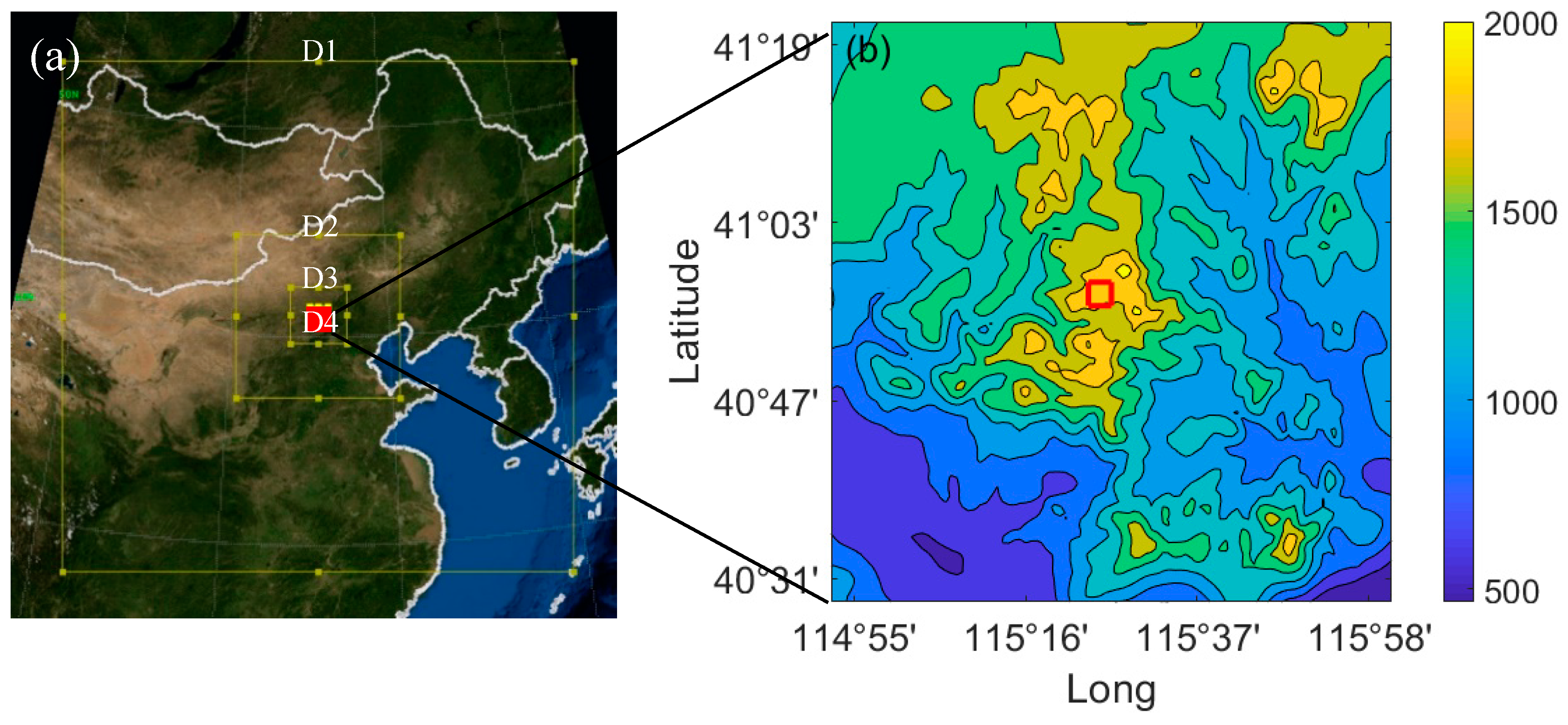
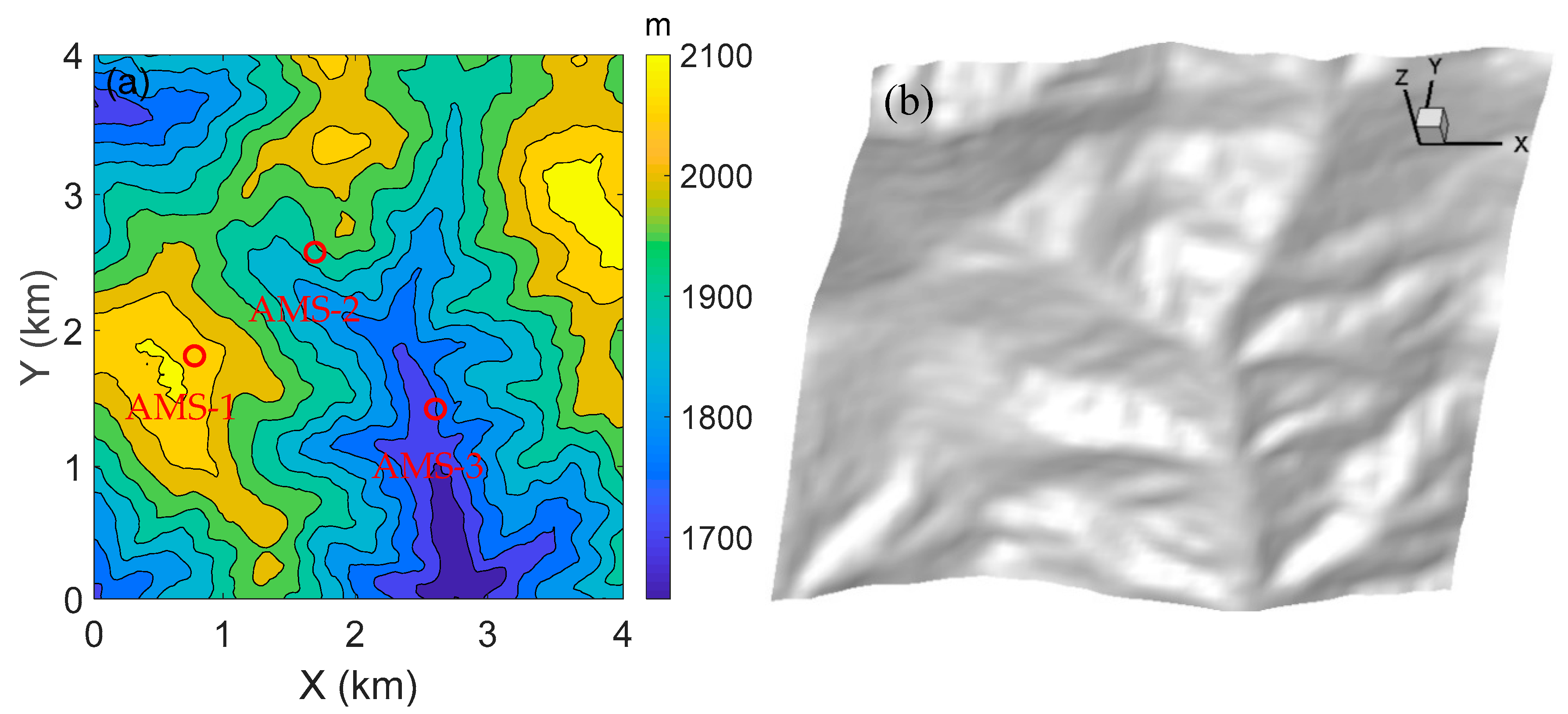
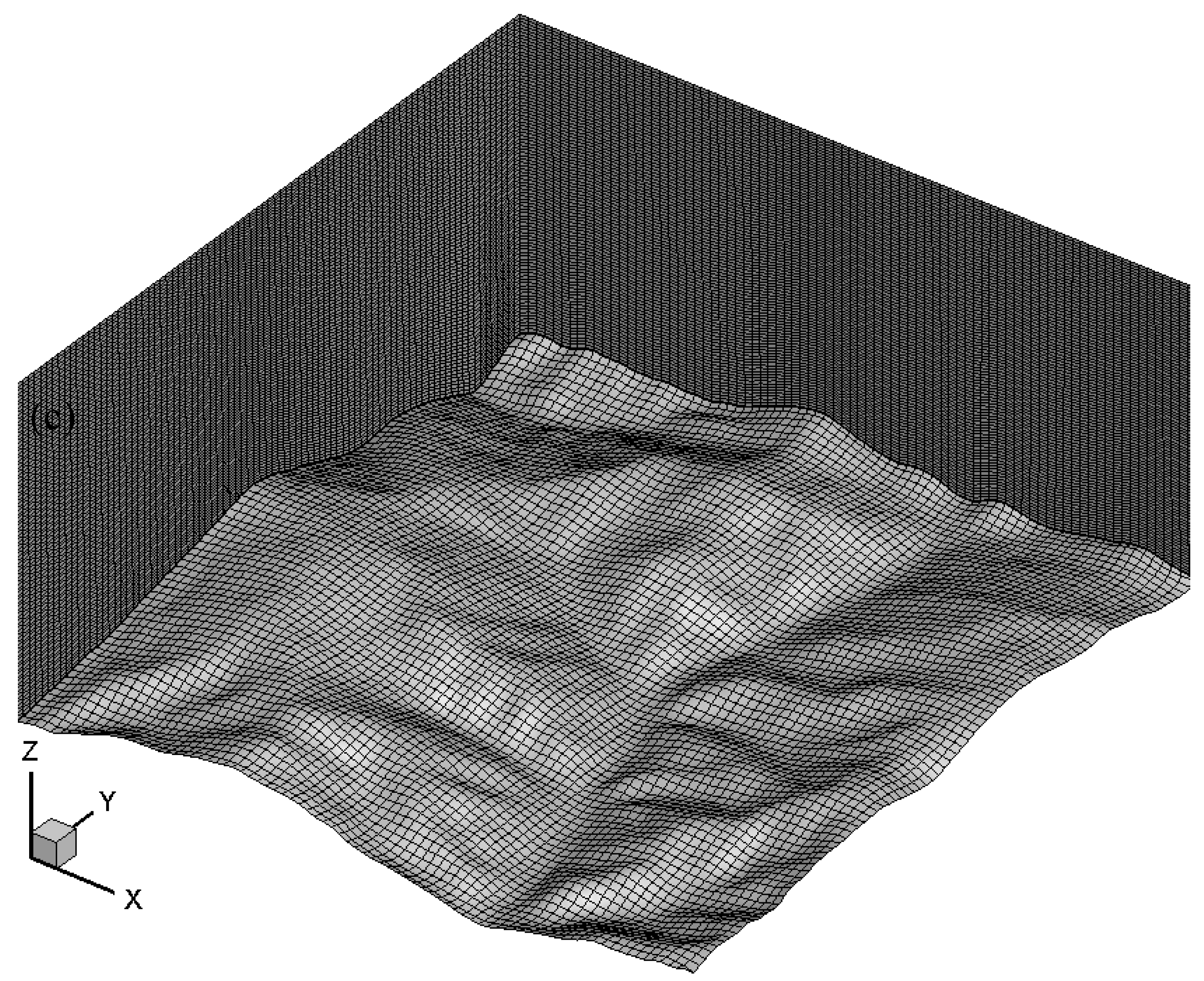
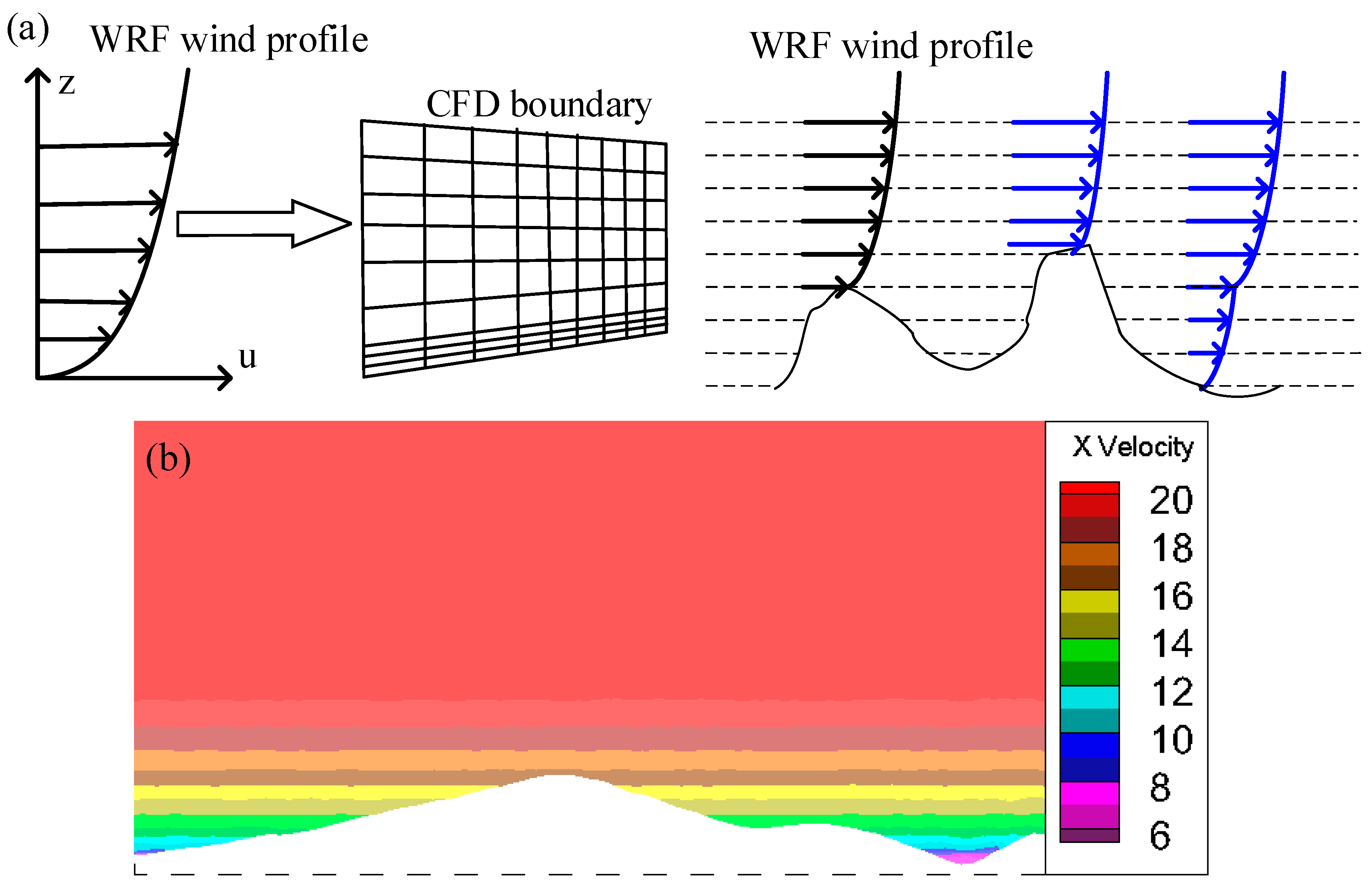
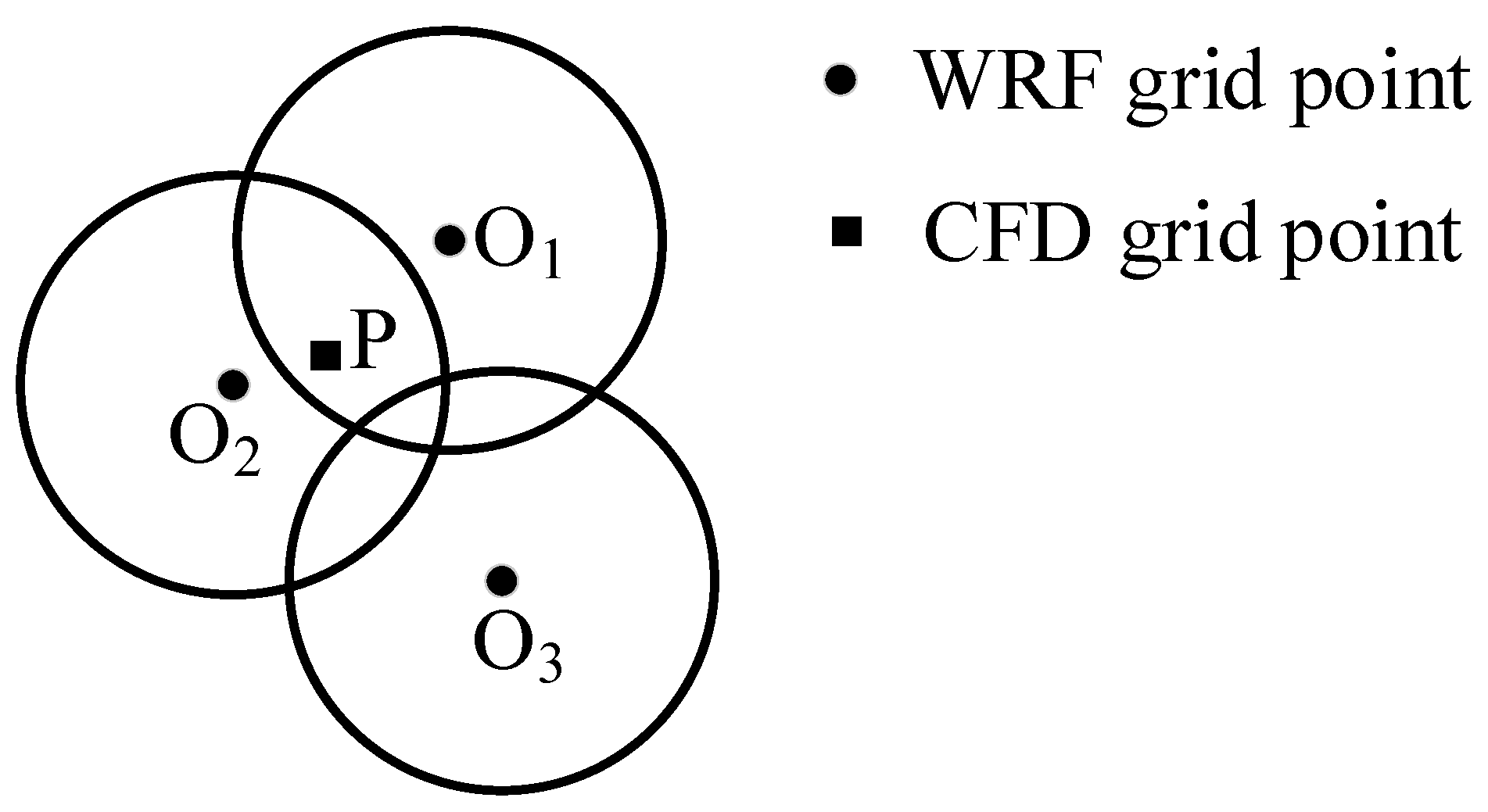
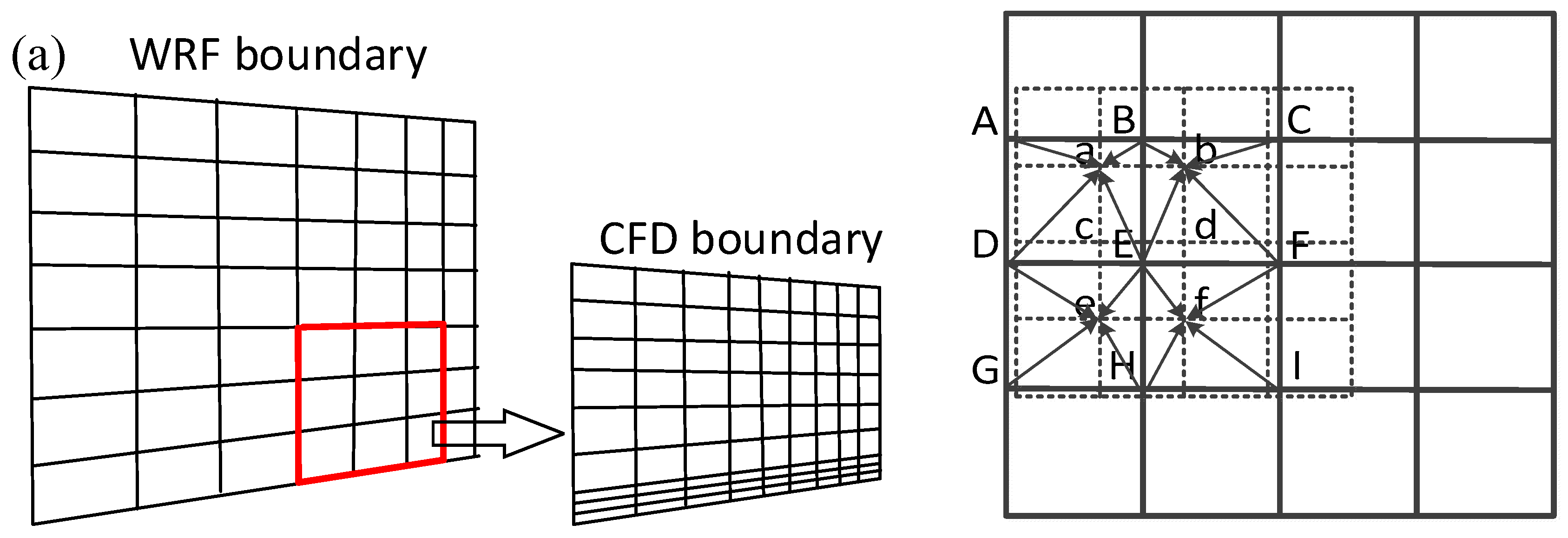

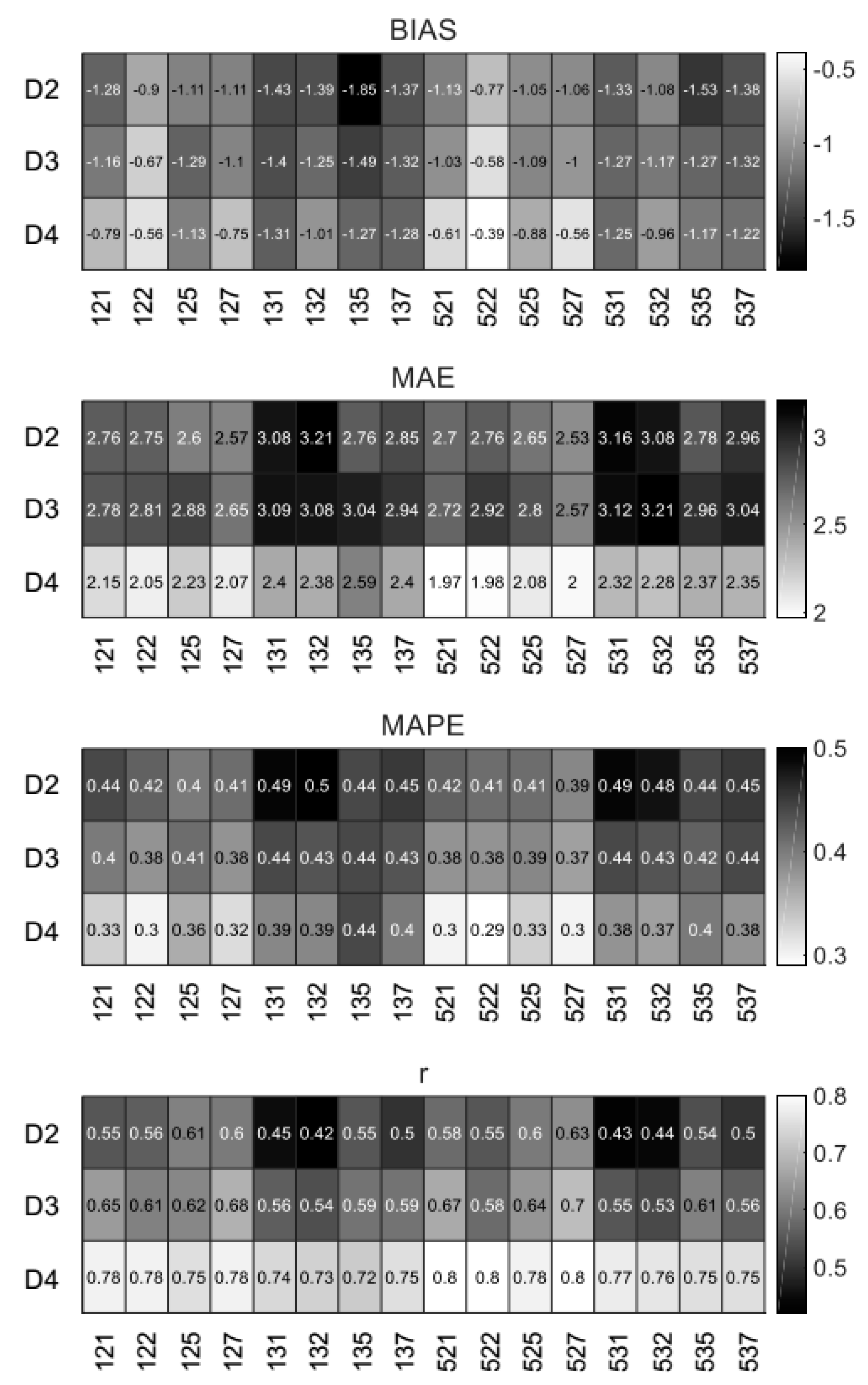
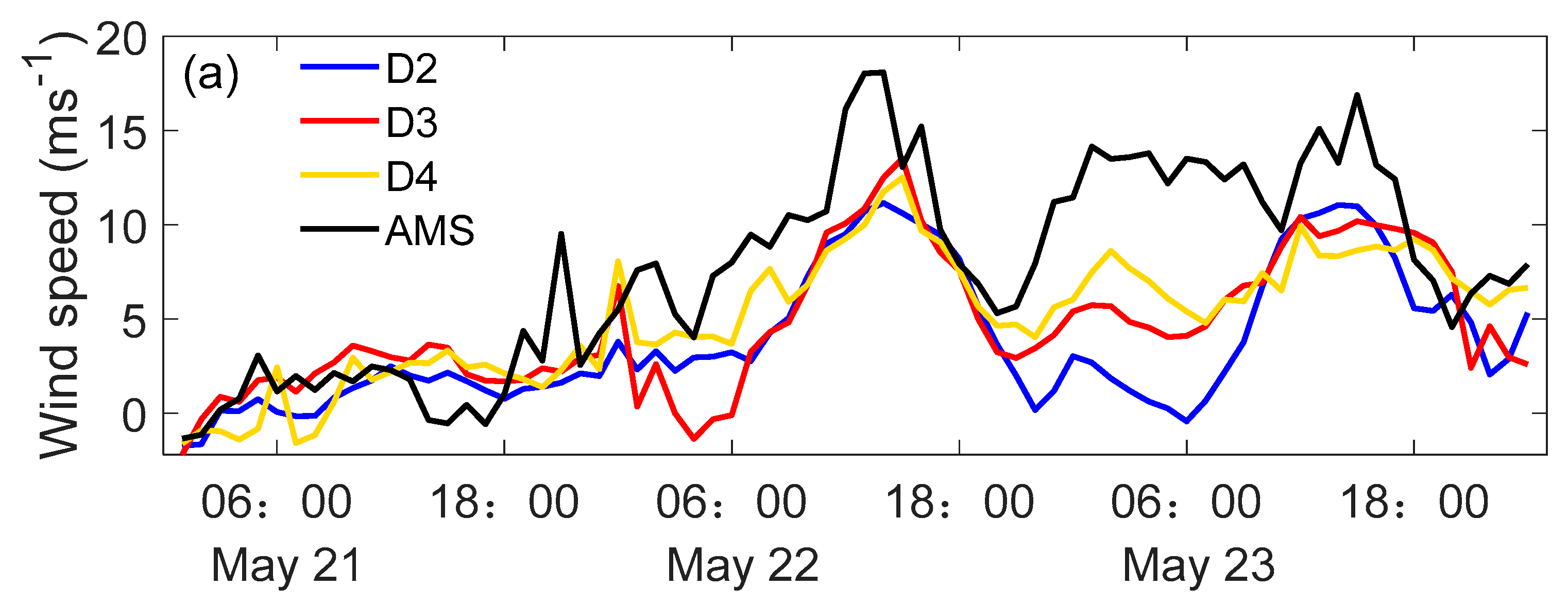
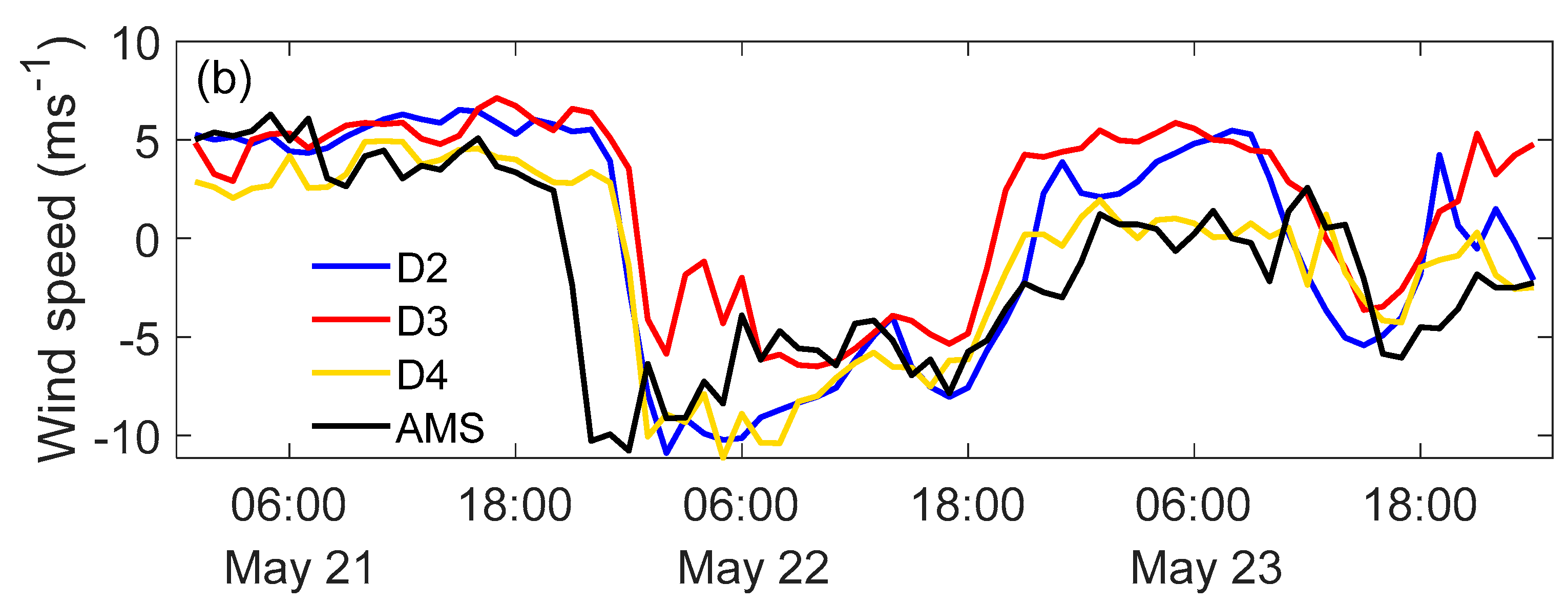
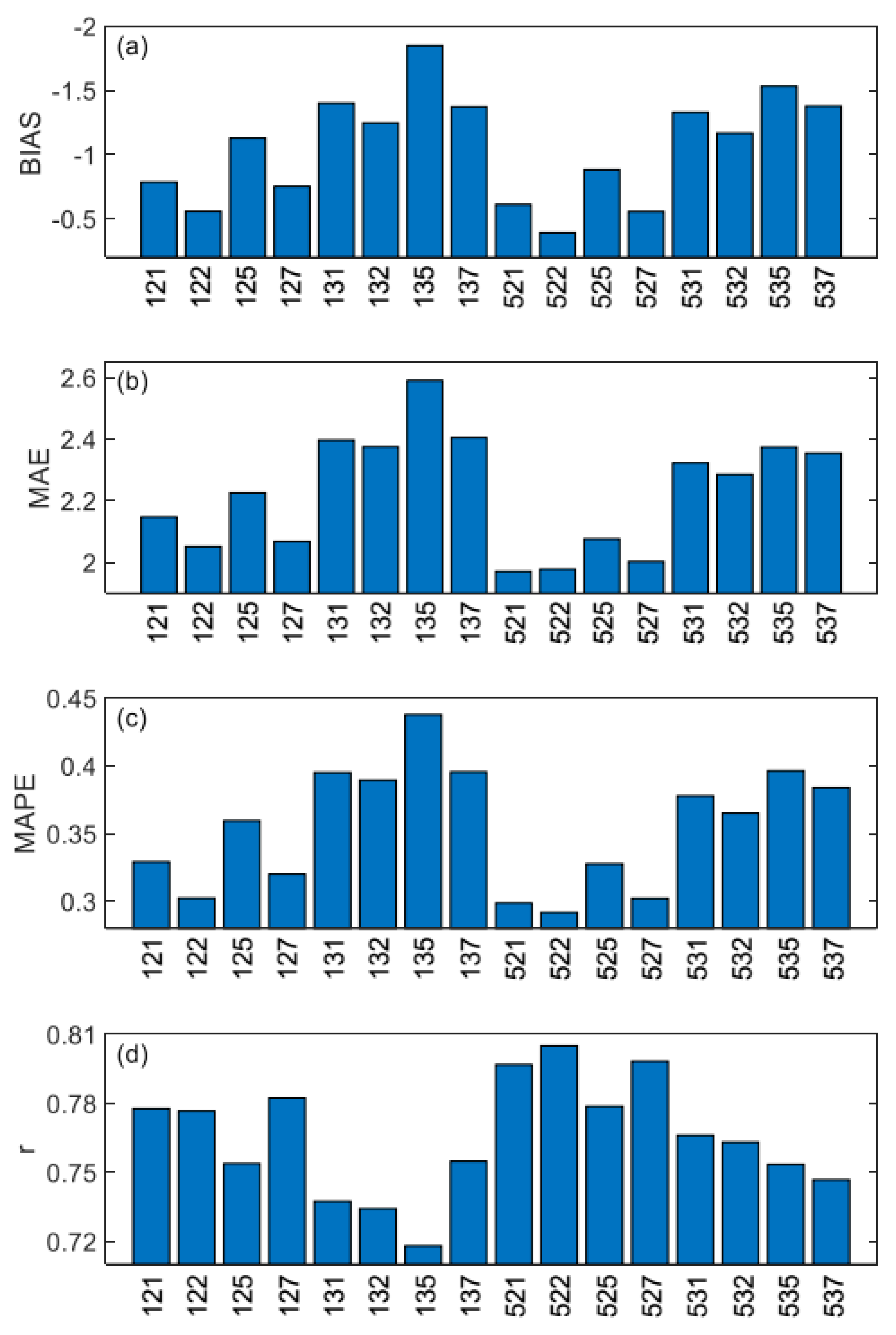
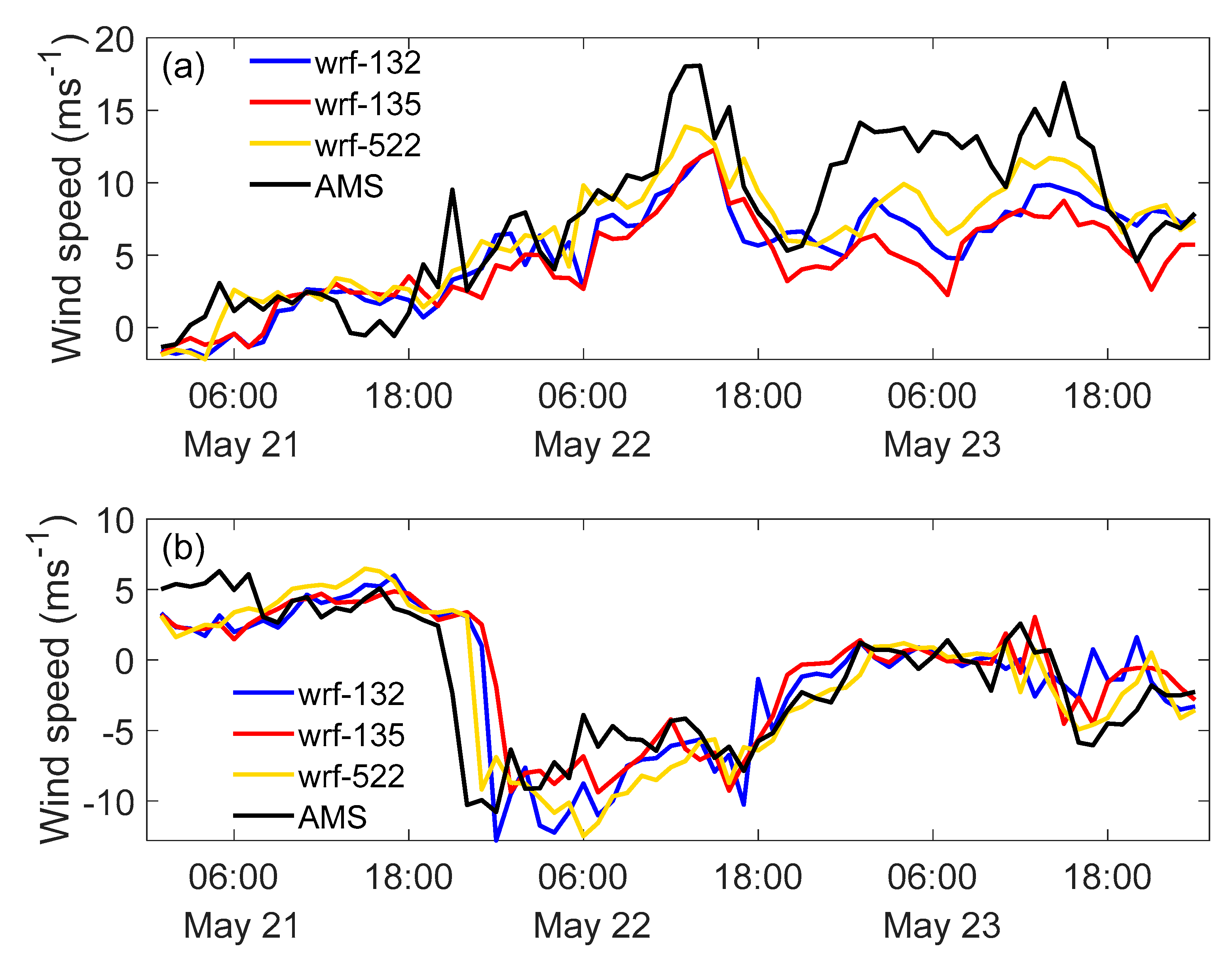
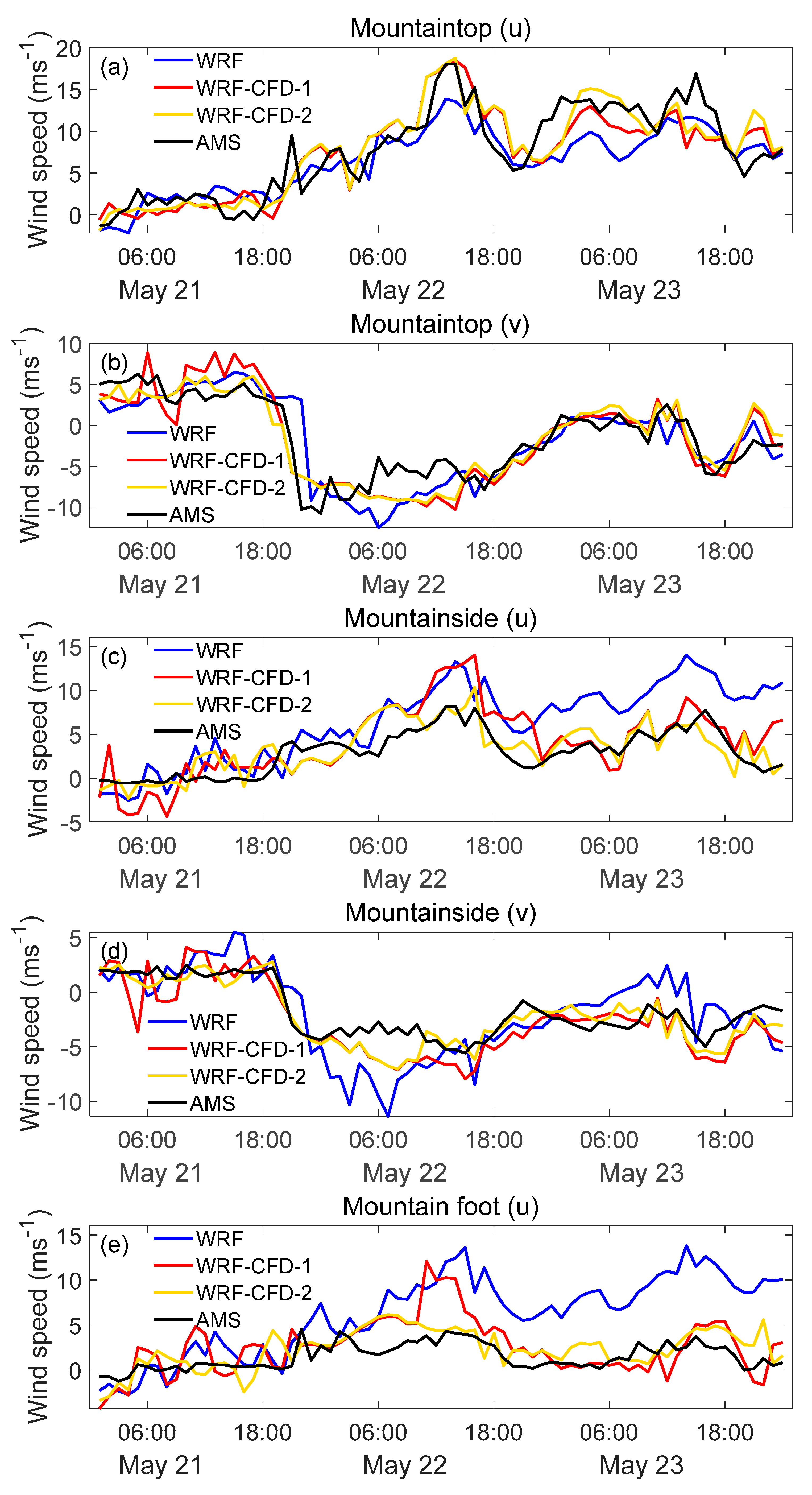
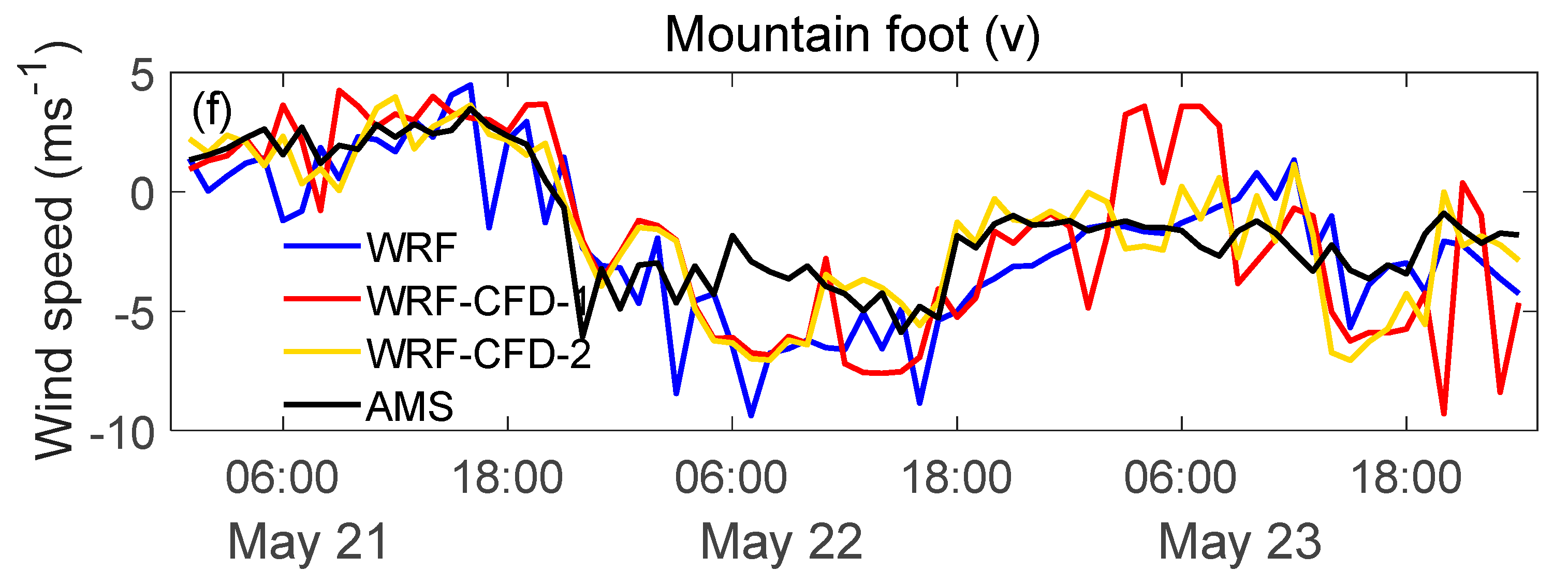
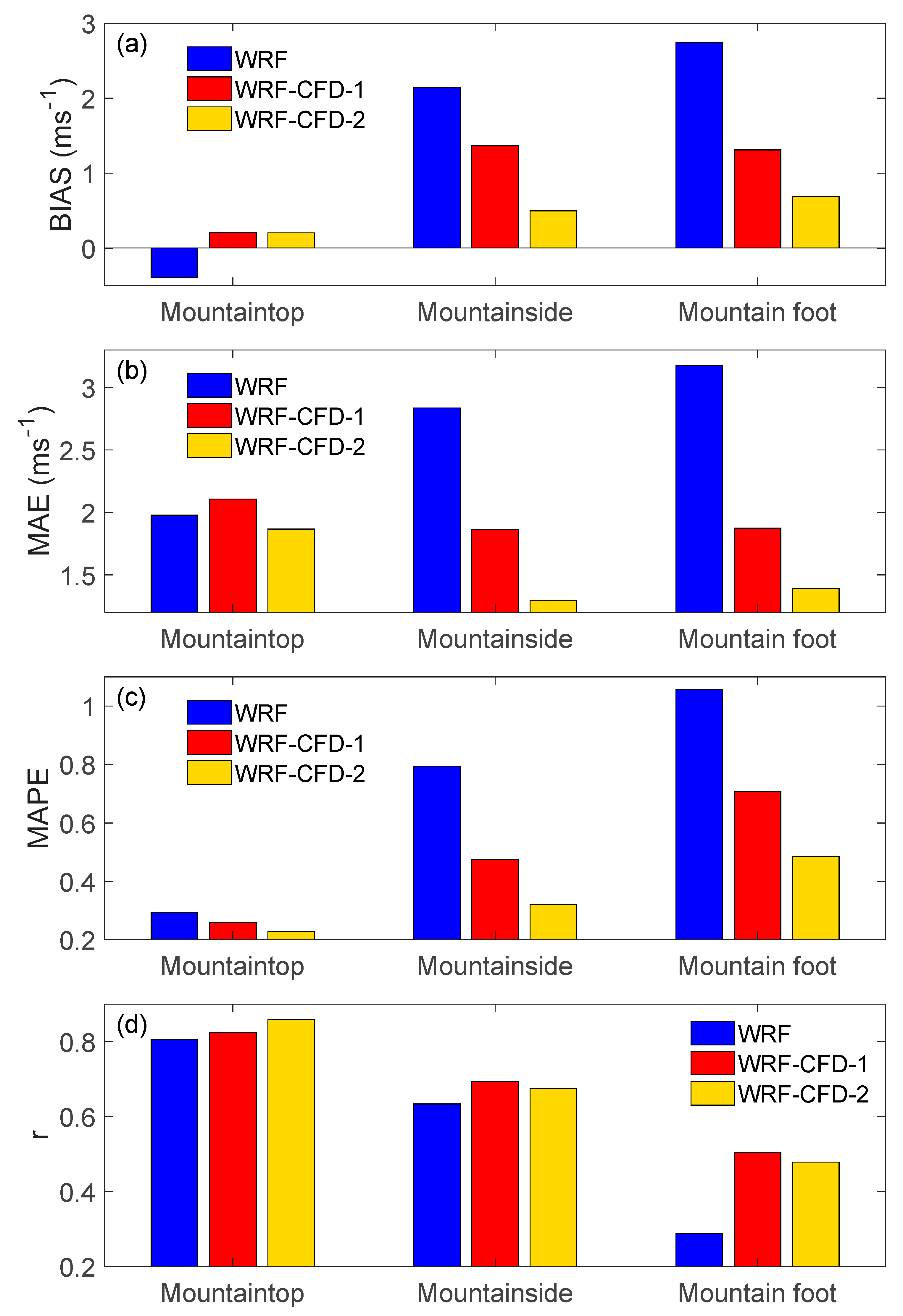
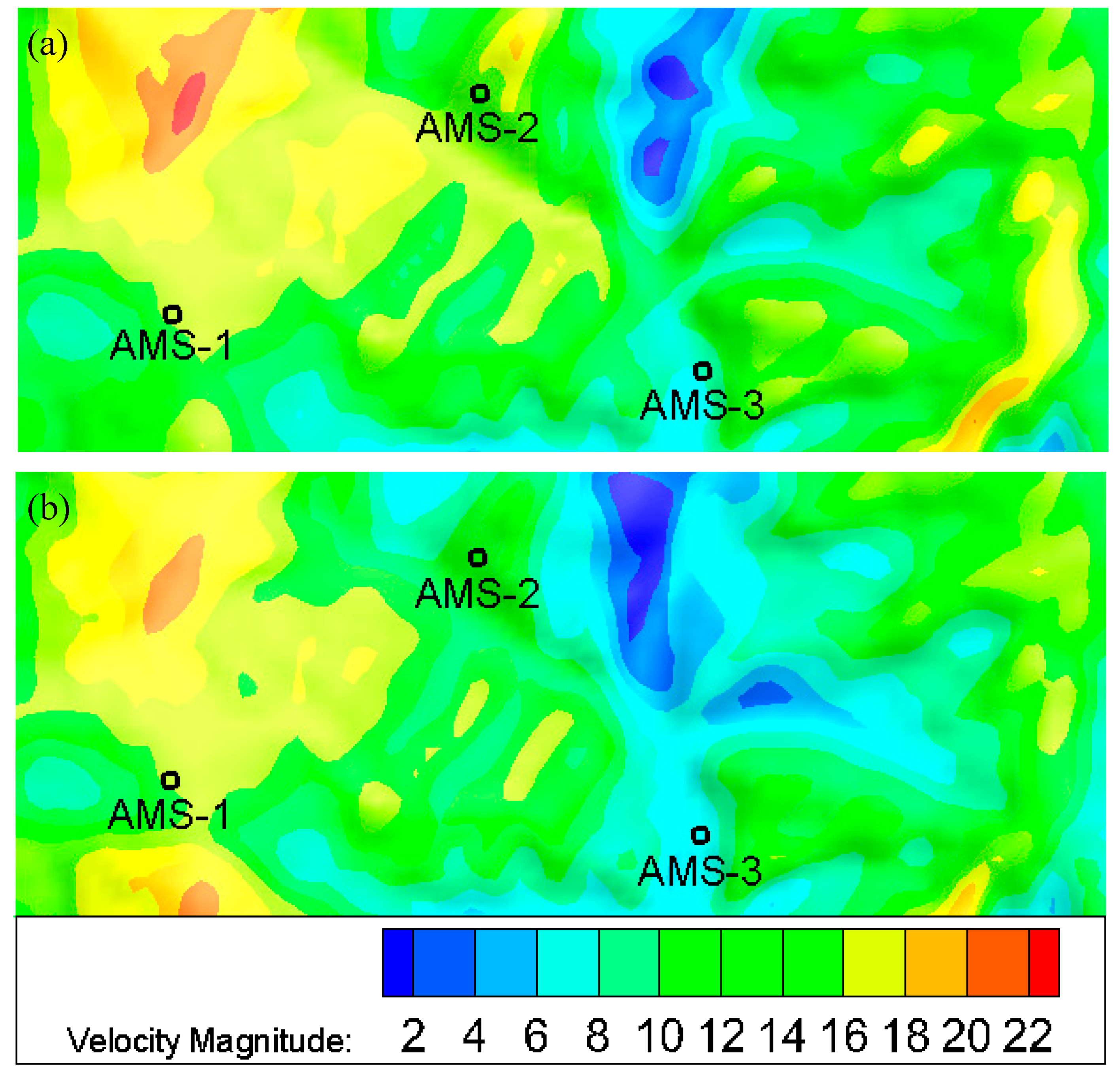
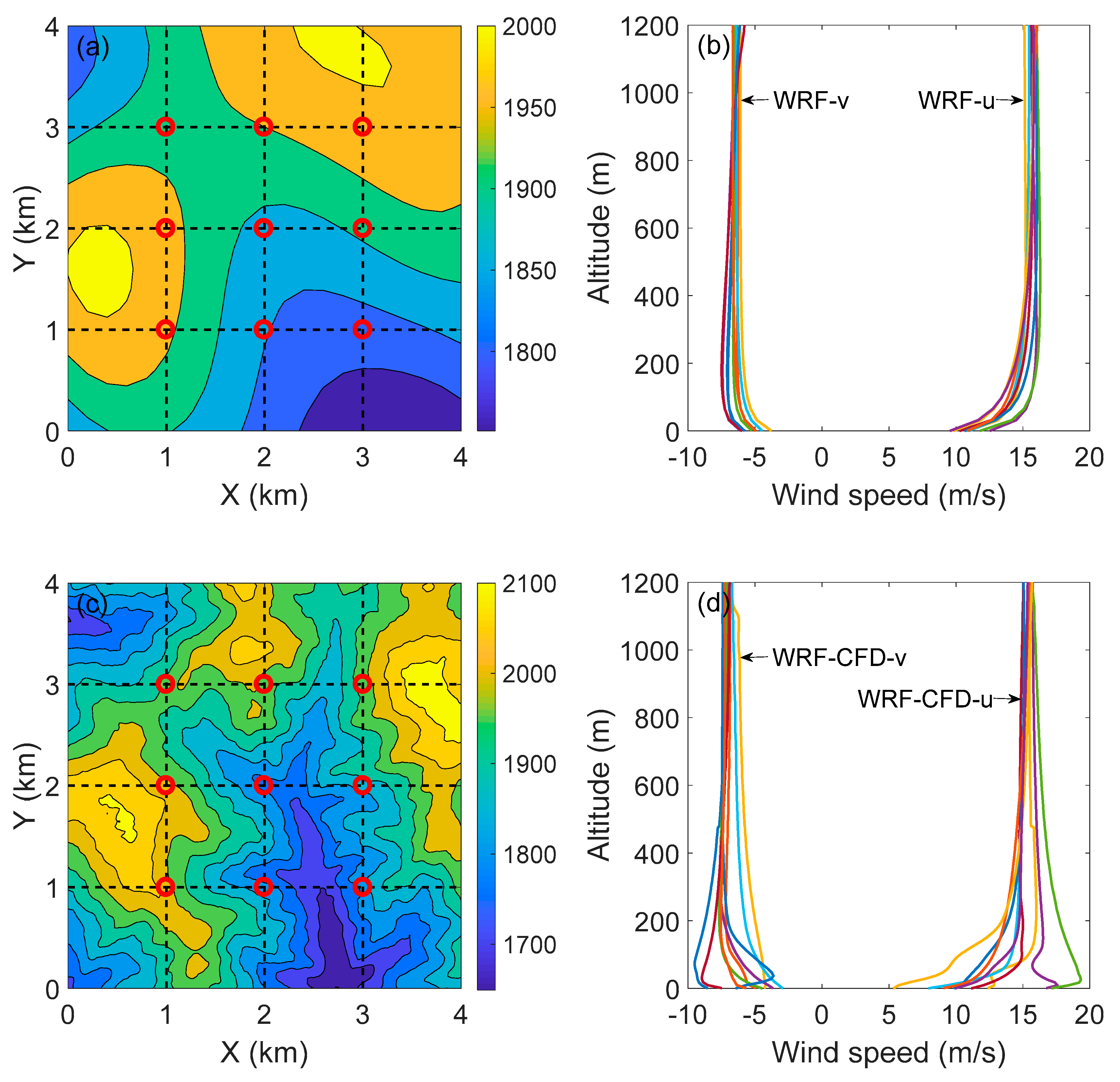
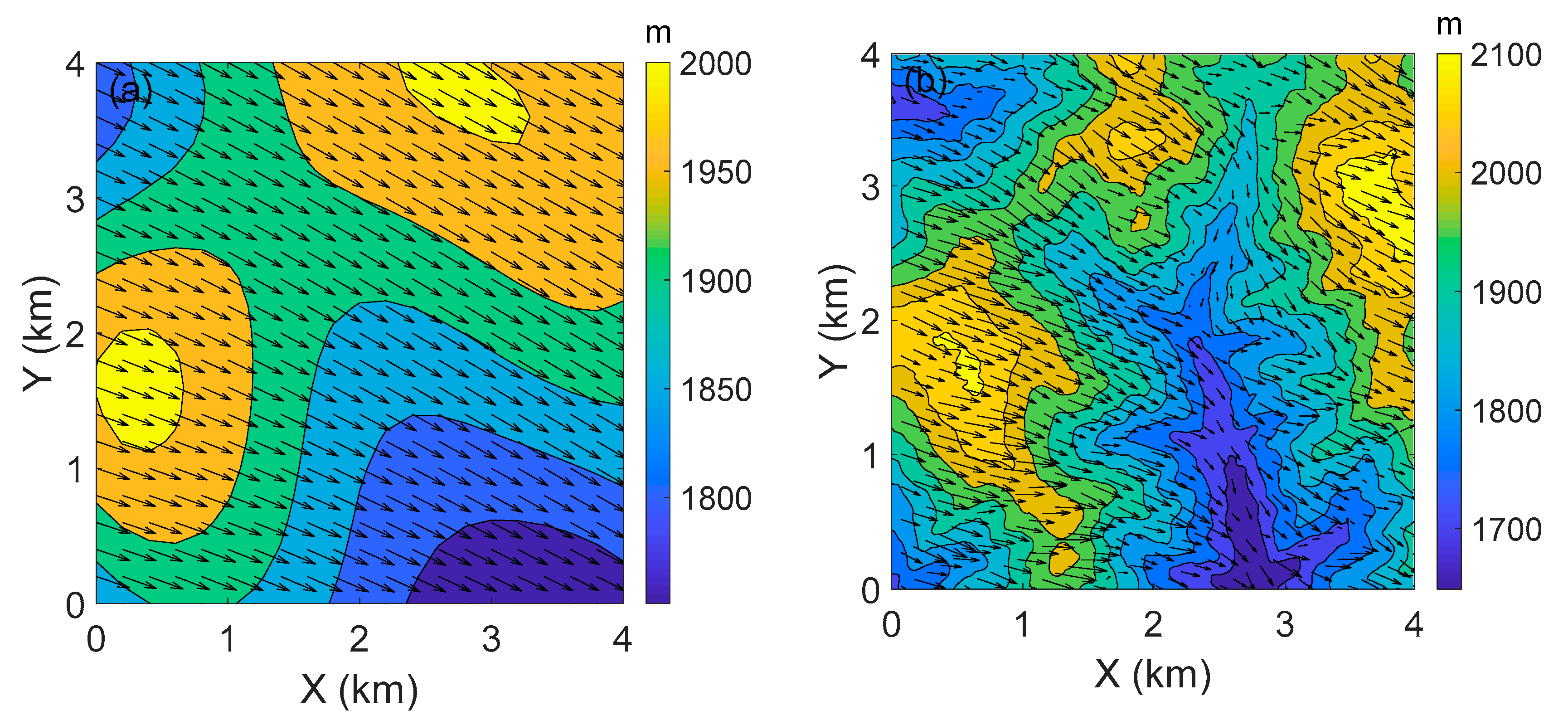
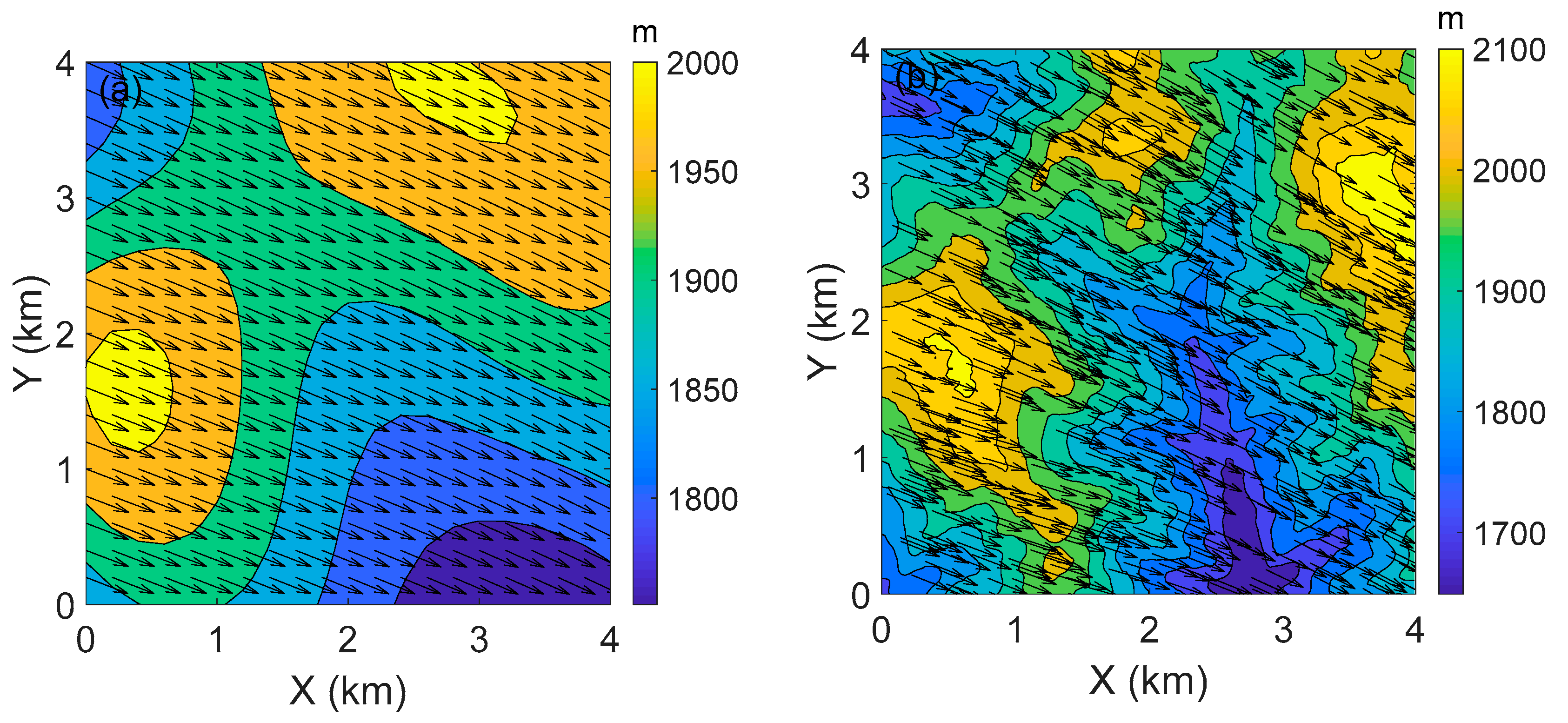
| Domain | Horizontal Resolution (km) | Grid Points | Time-Step (s) |
|---|---|---|---|
| D1 | 27 | 100 × 100 | 108 |
| D2 | 9 | 100 × 100 | 36 |
| D3 | 3 | 100 × 100 | 12 |
| D4 | 1 | 100 × 100 | 4 |
| Simulation Code | Radiation Scheme (Shortwave/Longwave) | Land Surface Scheme | PBL Scheme |
|---|---|---|---|
| WRF-121 | MM5/RRTM | NLSM | YSU |
| WRF-122 | MM5/RRTM | NLSM | MYJ |
| WRF-125 | MM5/RRTM | NLSM | MYNN |
| WRF-127 | MM5/RRTM | NLSM | ACM2 |
| WRF-131 | MM5/RRTM | RUC | YSU |
| WRF-132 | MM5/RRTM | RUC | MYJ |
| WRF-135 | MM5/RRTM | RUC | MYNN |
| WRF-137 | MM5/RRTM | RUC | ACM2 |
| WRF-521 | NG/NG | NLSM | YSU |
| WRF-522 | NG/NG | NLSM | MYJ |
| WRF-525 | NG/NG | NLSM | MYNN |
| WRF-527 | NG/NG | NLSM | ACM2 |
| WRF-531 | NG/NG | RUC | YSU |
| WRF-532 | NG/NG | RUC | MYJ |
| WRF-535 | NG/NG | RUC | MYNN |
| WRF-537 | NG/NG | RUC | ACM2 |
© 2019 by the authors. Licensee MDPI, Basel, Switzerland. This article is an open access article distributed under the terms and conditions of the Creative Commons Attribution (CC BY) license (http://creativecommons.org/licenses/by/4.0/).
Share and Cite
Li, S.; Sun, X.; Zhang, S.; Zhao, S.; Zhang, R. A Study on Microscale Wind Simulations with a Coupled WRF–CFD Model in the Chongli Mountain Region of Hebei Province, China. Atmosphere 2019, 10, 731. https://doi.org/10.3390/atmos10120731
Li S, Sun X, Zhang S, Zhao S, Zhang R. A Study on Microscale Wind Simulations with a Coupled WRF–CFD Model in the Chongli Mountain Region of Hebei Province, China. Atmosphere. 2019; 10(12):731. https://doi.org/10.3390/atmos10120731
Chicago/Turabian StyleLi, Shaohui, Xuejin Sun, Shan Zhang, Shijun Zhao, and Riwei Zhang. 2019. "A Study on Microscale Wind Simulations with a Coupled WRF–CFD Model in the Chongli Mountain Region of Hebei Province, China" Atmosphere 10, no. 12: 731. https://doi.org/10.3390/atmos10120731
APA StyleLi, S., Sun, X., Zhang, S., Zhao, S., & Zhang, R. (2019). A Study on Microscale Wind Simulations with a Coupled WRF–CFD Model in the Chongli Mountain Region of Hebei Province, China. Atmosphere, 10(12), 731. https://doi.org/10.3390/atmos10120731





